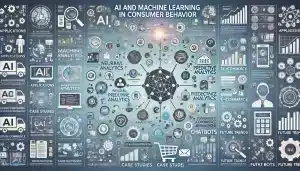Consumer behavior in the modern digital landscape is extremely vital for any business looking to survive. Advances in AI and Machine Learning have modified how companies process consumer data and forecast trends. This piece examines the relationship between AI, ML, and consumer behavior: their definitions, applications, and the way technology has changed the way businesses think.
What is the Difference Between AI and Machine Learning?
Understanding the Basics of AI and ML
Artificial intelligence refers to the simulation of human intelligence processes by computer systems. This encompasses a range of technologies, including natural language processing, speech recognition, and computer vision. Machine learning, on the other hand, is a subset of AI that focuses on the development of algorithms that allow computers to learn from and make predictions based on data. The difference between artificial intelligence and machine learning lies in their scope; while AI encompasses a broader set of technologies, machine learning specifically deals with the computer’s ability to learn from input data without being explicitly programmed for every task.
How AI and Machine Learning Interact
The interaction between AI and machine learning is fundamental to modern data analysis. It uses machine learning algorithms for training AI systems, which allows identification of patterns and decision making based on vast amounts of data, hence enabling automation in the processing of data and enhancing the capabilities of AI systems when used in predictive analytics and modeling consumer behaviors. For instance, AI systems that apply machine learning are bound to improve their performance over time with more data processing. This means that the insights from the consumers’ preferences and behavior are bound to be accurate.
Common Misconceptions about AI vs Machine Learning
There are various misconceptions about the differences between AI and machine learning. Many people believe that all AI systems apply machine learning, which is not true. While machine learning is indeed a powerful tool within the AI toolkit, AI can function in other ways without relying on machine learning, using rule-based systems to make decisions. Another term that causes confusion regarding capabilities is “AI vs machine learning.“ Knowing that machine learning is simply a means to an AI end can help to dispel the confusion and get businesses using these technologies in more effective ways.
How Do Companies Use AI and Machine Learning to Analyze Consumer Behavior?
Application of AI in Consumer Data Analysis
The use of AI is turning companies towards consumer data analysis, using machine learning algorithms for the processing and interpretation of big data. As such, AI enables businesses to have insights on customers’ preferences, trends, and behaviors. For example, retailers will look into specific purchasing trends to optimize the inventory and maximize marketing strategies. Companies can predict future consumer actions and adjust their offerings with the application of machine learning models to improve customer satisfaction and loyalty.
Examples of Companies Implementing Machine Learning
Several industry leaders have successfully integrated machine learning into their consumer behavior analysis. For example, Netflix employs machine learning algorithms to recommend shows and movies based on user viewing history. This personalized approach not only increases user engagement but also helps the company retain subscribers. Similarly, Amazon utilizes AI and machine learning to analyze customer reviews and purchasing patterns, enabling them to suggest relevant products to consumers. Such implementations underscore the effectiveness of using AI and machine learning in understanding and responding to consumer behavior.
Case Studies on Successful AI and ML Integration
Case studies illustrate the success of AI and machine learning integration in consumer behavior analysis. One notable example is Starbucks, which uses predictive analytics to optimize store locations based on demographic data and consumer behavior patterns. By applying machine learning algorithms to historical data, Starbucks can identify trends and make informed decisions about new store openings. Another case study involves Spotify, which employs machine learning to curate personalized playlists based on user listening habits, enhancing the overall user experience and fostering brand loyalty. These examples highlight how companies can effectively use AI and machine learning to drive business growth.
What Are the Key Applications of Machine Learning in Consumer Insights?
Predictive Analytics for Enhancing Customer Experience
Predictive analytics is a key application of machine learning in enhancing customer experience. By analyzing historical data, machine learning models can forecast future consumer behavior, allowing businesses to tailor their offerings. For instance, e-commerce platforms can predict which products a customer is likely to purchase based on their browsing history and previous purchases. This capability not only improves customer satisfaction but also increases sales conversion rates by presenting consumers with relevant options at the right time.
Using AI for Fraud Detection in Consumer Transactions
Fraud detection is another significant application of AI in consumer transactions. Machine learning systems can analyze transaction patterns in real-time, identifying anomalies that may indicate fraudulent activity. By automating the detection process, companies can respond more swiftly to potential threats, protecting their customers and their bottom line. For example, financial institutions leverage machine learning algorithms to continuously monitor transactions, thereby reducing instances of fraud and enhancing customer trust in their services.
Deep Learning Techniques in Customer Behavior Prediction
Deep learning techniques, a subset of machine learning, have proven invaluable in predicting customer behavior. Using artificial neural networks, businesses can analyze complex datasets to identify intricate patterns in consumer behavior. These deep learning models excel in tasks such as image and speech recognition, allowing companies to refine their marketing strategies. For instance, retailers can use computer vision technologies to analyze in-store customer interactions, tailoring the shopping experience based on observed behaviors.
How Does Deep Learning Improve AI Systems in Understanding Consumer Patterns?
Neural Networks and Their Role in Data Analysis
Neural networks are the backbone of many AI systems for analyzing consumer patterns, as it’s a critical component in deep learning. It consists of several artificial neurons connected together and acts like the human brain that processes complex data structures. Neural networks can learn from huge amounts of data, so AI systems can find subtle patterns that traditional algorithms may miss. This is especially useful in consumer behavior analysis, where understanding nuances can make a big difference in marketing strategies.
Automating Consumer Insights with Deep Learning
Consumer insight may therefore become automated through deep learning that minimizes human intervention while finding actionable intelligence from data by an organization. Deep learning aids an entity, allowing businesses to automate processes such as customer reviews by analyzing the sentiment from both a review and social media so that the company may automatically respond to the everchanging consumer sentiments.
Training Data and Its Impact on Machine Learning Models
The quality of training data has a significant impact on the effectiveness of machine learning models. Well-curated training data allows machine learning systems to learn efficiently and make accurate predictions. Poor-quality data, however, can result in biased or inaccurate models, which may negatively impact business outcomes. The only way for companies to get reliable insights into consumer behavior from their AI and machine learning systems is to invest in data quality management. Companies need to make a move towards training data to make the machine learning algorithms perform better, which would allow them to get a deeper understanding of their customers.
What Are the Differences Between AI and ML in Consumer Behavior Analysis?
Defining AI and ML in the Context of Consumer Behavior
In consumer behavior analysis, AI represents the ability of a machine to simulate human intelligence, whereas machine learning specifically talks about methodologies that make it possible for machines to learn and adapt. It is, therefore important for businesses to understand the differences between the two to deploy these technologies effectively. Different approaches exist for using AI systems, such as those based on machine learning. Machine learning models, however can work autonomously and analyze the data to extract information about the consumers.
How Each Technology Addresses Consumer Needs
AI and machine learning each address consumer needs in different ways. AI systems can process data and provide insights, while machine learning focuses on learning from data to improve predictions over time. For instance, AI can automate customer support through chatbots, enhancing service efficiency, while machine learning can analyze customer feedback to refine product offerings. Together, they create a comprehensive approach to understanding and fulfilling consumer needs, ultimately driving business success.
Future Trends in AI and Machine Learning Applications
As technology continues to evolve, the future of AI and machine learning applications in consumer behavior analysis looks promising. Emerging trends such as reinforcement learning and unsupervised learning are set to enhance the capabilities of AI systems further. Companies are expected to leverage these advancements to create personalized consumer experiences and improve decision-making processes. Additionally, the integration of AI and machine learning with other technologies, such as the Internet of Things (IoT), will provide deeper insights into consumer behavior, allowing businesses to stay ahead in a competitive marketplace.



